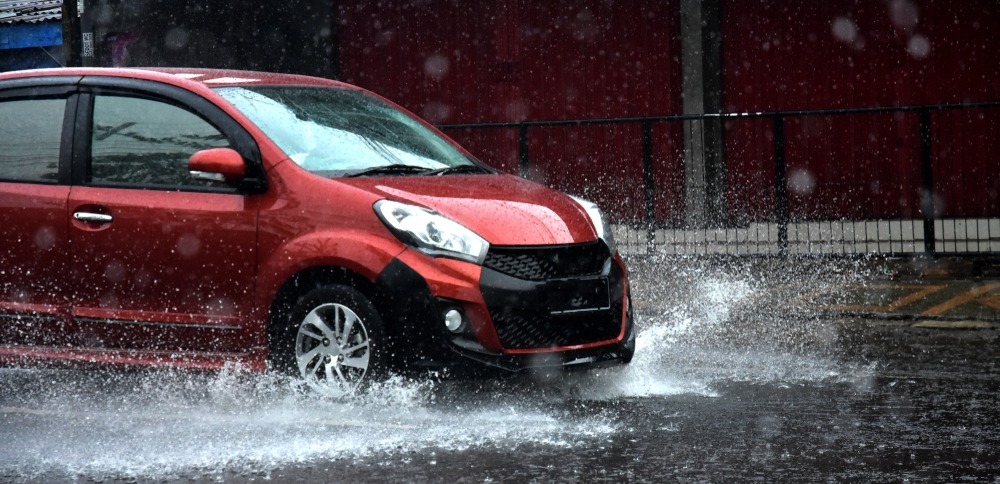- January 12, 2022
- Posted by: Wentworth
- Category: Brakes

 We all know that rainy driving conditions can create more stress for motorists. But do you know why wet roads cause issues with your brakes and how much they increase your stopping distance? Keep reading to discover how to safeguard your vehicle against the dangers of rainy driving and learn what to do in vehicle emergencies.
We all know that rainy driving conditions can create more stress for motorists. But do you know why wet roads cause issues with your brakes and how much they increase your stopping distance? Keep reading to discover how to safeguard your vehicle against the dangers of rainy driving and learn what to do in vehicle emergencies.
Rainy Driving: Wet Roads Safety Tips
To keep yourself and your passengers safe while driving in wet weather, remember to slow down, stay aware of your surroundings, and reduce distractions. Here are a few more safety tips to consider when driving on wet roads.
Brakes & Stopping Distance
Did you know that your vehicle’s stopping distance is TWICE as long on wet roads compared to dry roads? First, we must see the need to slow down or stop, which can be more challenging in reduced visibility. Next, we must react to the need by engaging the brake pedal. Finally, the vehicle’s braking system must reduce its momentum until it comes to a complete stop. Slippery roads and excessive water on the roadway can impede the braking system. When driving in wet conditions, increase the distance between your car and the car you are following. The bigger the gap, the more stopping distance you allow yourself.
Brakes & Hydroplaning
Hydroplaning occurs when the tire’s footprint loses contact with the road due to excess water. This loss of traction can happen when the vehicle travels faster than the road conditions allow or leaves & shadows hide an unseen water hazard (like a deep or large puddle). To prevent the likelihood of hydroplaning, reduce your driving speed and drive in the tire tread marks of the vehicle in front of you. If rain is falling heavily enough that you can no longer see clearly, pull off the road or exit the highway until conditions improve.
Brakes & Deep Water
Driving through deep water or large bodies of water on the road is never wise. There may be hidden road debris, deep potholes, or sinkholes that can cause your vehicle to get stuck. If the water is deep enough to submerge your tailpipe, your car may stall and be unable to start again. If the water is moving swiftly enough, it may lift your vehicle free of the road and cause it to drift ‘downstream,’ causing injuries to yourself or others.
Rainy Driving: Vehicle Emergencies
Even with our best efforts, sometimes vehicle emergencies can arise. Rainy driving conditions can create very specific vehicle emergencies. Here are a few issues you may have to deal with in wet driving conditions.
Wet Brakes
If you have been driving in heavy rain or found yourself going through deep puddles, your vehicle may have wet brakes. Wet brakes may not work effectively in emergency conditions. You can test your brakes by tapping or lightly engaging the brake pedal several times. If the brakes don’t engage, don’t panic. Keep your foot off the gas and engage the brake pedal again lightly – don’t slam the brake pedal to the floor. Keep your speed low; you can even put your car into low gear. As the brake components start to dry, your vehicle may pull to one side. Continue to steer straight. Release the brakes and re-engage until the brakes operate normally again.
Flat Tire or Tire Blowout
Wet weather combined with high speeds can cause your car to skid or hydroplane. If your driving speed was fast enough, you might find that sufficient tire damage occurred to cause a blow-out or a flat tire.
If this happens while you are still driving, take your foot off the gas and disengage cruise control. Steer your car in the direction you want to go, but be aware that the vehicle will pull towards the flat tire. Slow down gradually, but do not stomp on the brakes. Once you feel you have the car under control, brake softly and pull off the road before coming to a complete stop.
Give yourself plenty of room away from the flow of traffic. Engage your hazard lights and put out the reflective items from your emergency kit before changing your tire.
Rainy Driving: Vehicle Safety Concerns
Driving in the rain can bring up a few vehicle safety concerns. It is a good idea to familiarize yourself with the following components of your vehicle. Hence, you will know what to do – and what not to do – in rainy driving conditions.
Braking System
Traditional braking systems use friction to slow down the vehicle. Friction creates a lot of heat. While your car’s braking system is designed to dissipate heat, drivers need to use caution when driving in cold, wet weather. Hot brake components (drums, rotors, calipers, pads) may become warped or cracked when suddenly submerged in cold water. Whenever possible, avoid driving through deep puddles & large pools of standing water.
Brake Fluid
Brake fluid flows in a sealed system. Check your vehicle’s brake fluid regularly and occasionally flush it as part of your factory-recommended routine maintenance. However, even with regular inspections, brake fluid may become contaminated by excessive moisture absorbed through worn hoses, gaskets, or other seals. If this happens, several braking issues can occur:
- Water lowers the boiling point of the brake fluid (which is bad), so pockets of steam accumulate in the brake lines. This can negatively affect stopping ability.
- If moisture gets into the brake fluid, it can become corrosive to the metal components in the braking system.
- Overheated brake fluid (due to water in the system) can burn. Burned brake fluid should be flushed and refilled with fresh fluid to maintain safe braking.
Tires
Tire tread patterns disperse water from the roadway. The gaps between the tread allow the liquid to escape from under the tire’s footprint (where the tire and road meet). As the tread wears down, less water can escape, reducing traction. Additionally, tires with low air pressure squeeze the tread channels together, impeding water flow and reducing traction. Maintain the correct tire pressure and inspect tire tread routinely when driving in rainy weather.
Rainy Driving: Brakes Maintenance
Driving safely in rainy weather starts with good routine vehicle maintenance. Bring your vehicle to Wentworth Automotive in San Diego, CA, for a comprehensive service. Our team of experienced technicians can inspect your brake system, check your tires, and change out your wiper blades quickly and efficiently.
Make A Reservation
We would love to see you – call us at (858)541-1044 or visit our website to make a service reservation today!

